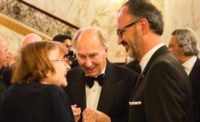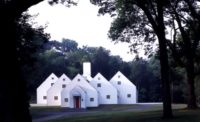When this magazine declared the Walker Art Center in Minneapolis “America’s leading museum of design” in 1990 [RECORD, March 1990, pages 45-47], it was paying tribute to Mildred Friedman, who died on September 3, at 85, in New York City.
 |
| Photo courtesy Martin Friedman A portrait of the young Mildred Friedman. |
Beginning in 1969, Mildred—who went by Mickey—had been the museum’s go-to-person for anything and everything relating to design. She was best known for curating a series of prescient exhibitions on architecture and design while editing the Walker’s incisive and influential Design Quarterly. At the same time, she presided over a design studio that produced the Walker’s award-winning catalogues and signage. She also wrote (or co-wrote) dozens of books, most of them on architecture, and served as an informal design advisor to Minneapolis grandees, finding commissions for Philip Johnson, Cesar Pelli and, eventually, Frank Gehry, in and around that city.
And that was all before 1990, the year she and her husband Martin, the Walker’s director for 28 years, “retired” and moved to New York. In the ensuing decades, she curated shows at the Guggenheim Museum, the Canadian Centre for Architecture, and the Brooklyn Museum; consulted for the Battery Park City Authority; and wrote many more books (the most recent was Frank Gehry: The Houses, in 2009). And she followed the careers of architects whose work she had exhibited at the Walker, including Tod Williams and Billie Tsien, Thom Mayne, Elizabeth Diller and Ricardo Scofidio, Steven Holl, and of course Gehry. “We owed Mickey a lot,” said Billie Tsien, who added that she was speaking for herself and many other architects. Curators also owed her a lot. "She was in the vanguard of curators who saw themselves not just as conservators, but as people who made things happen—as impressarios," said Terence Riley, the chief curator of architecture and design at MoMA from 1991 to 2006.
Mickey Shenberg was raised in California, where her father manufactured beveled glass. In the 1940s, while studying at UCLA, she took a class in drawing taught by Martin Friedman, a graduate student in art history and painting. “It was evident she could draw better than he,” Martin wrote in an email Friday morning.
They married in 1949, and in 1958 Martin took a job as a curator at the Walker. Mickey, who had been teaching design, went to work at the Minneapolis architecture firm Cerny Associates (now defunct). In 1969 she became a design consultant to the Walker; at the time, Edward Larrabee Barnes was designing the Walker’s new building, and Mickey worked with him on the interiors. “A testament to the coherence of the Barnes-Friedman” design, said the museum’s senior design curator Andrew Blauvelt in a tribute to Mickey, “is the fact that its basic vocabulary survived the 2005 expansion by Herzog & de Meuron, down to the two-and-half-inch-thick, white laminate, parson-style desks and gallery benches.”
Soon she was running the graphics program and creating a series of exhibitions that were idea-driven but also experiential, reflecting her view that architecture could only be understood in three dimensions. In 1974 she presented New Learning Spaces and Places, about advances in education design. A 1975 show explored the process by which legendary designers George Nelson, Charles and Ray Eames, Alexander Girard, and Robert Propst created classic furniture for Herman Miller.
In 1981, she mounted “the definitive De Stijl show,” in the words of William Rubin, director of the Museum of Modern Art, presumably eating his heart out. In 1986 Tokyo: Form and Spirit featured pieces commissioned by Mickey and Martin from Arata Isozaki, Fumihiko Maki, Tadao Ando, Shiro Kuramata, and Toyo Ito, among others. The same year, she gave Gehry his first museum show, which—according to Paul Goldberger, then the architecture critic of The New York Times—“somewhat shamed other museums, which I suspect had not taken Frank Gehry as seriously as they should have, mistrusting his Los Angeles base. It fell to Mrs. Friedman in the middle of the country to give him the homage that failed to come from larger institutions.” The show is remembered for its room-sized wood fish (which Gehry created at Mickey’s request), but its effects were felt beyond the museum. In 1987, Gehry’s Winton Guest House opened in Orono and in 1990 he was commissioned to design the Weisman Art Museum at the University of Minnesota; Mickey had a hand in both.
From 1988 to 1991 she presented a series of shows under the title Architecture Tomorrow; they showcased the work of Williams and Tsien, Mayne and his then-partner Michael Rotondi, Frank Israel, Stanley Saitowitz, Diller and Scofidio, and others. In 1989, she presented Graphic Design in America: A Visual Language History, the first large-scale museum survey of the field. (She was as influential in the graphic design world as in the architecture world.) And while she was doing all those things, she was running the Design Quarterly, with help from guest editors like Denise Scott Brown, Rem Koolhaas, and ergonomics expert Bill Stumpf. She and Martin also raised three daughters.
Among the shows she curated after leaving the Walker was a 1999 standout at the Canadian Centre for Architecture: Carlo Scarpa, Architect: Intervening with History. Mickey wrote at the time, “Scarpa’s focus on the specificities of place, and his revival of architecture’s concern for narrative and symbol, engaged him in a subtle and sometimes subversive debate with the prevailing architectural concerns of the 1960s and 1970s.” In 2001, she mounted a landmark Gehry show at the Guggenheim Museum (installed by Frank Gehry and Edwin Chan). Herbert Muschamp wrote in the Times: “Nothing, not even familiarity with Mr. Gehry's buildings, can prepare you for the impact of seeing his work presented in Frank Lloyd Wright's magnificent rotunda.” That impact was one part Gehry, one part Wright, and one part Mickey Friedman.




